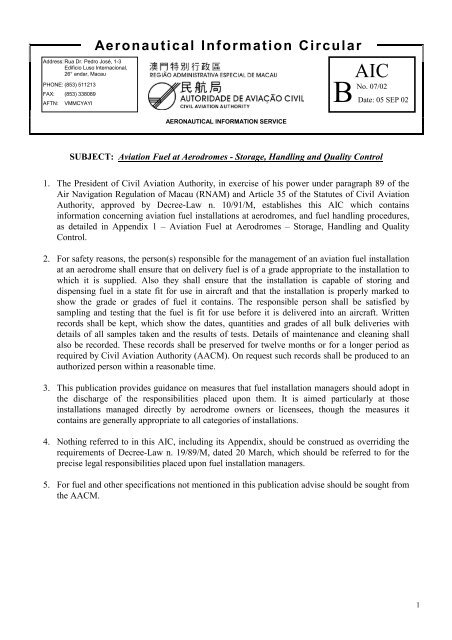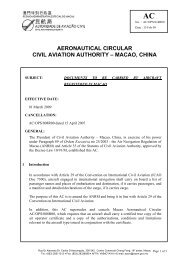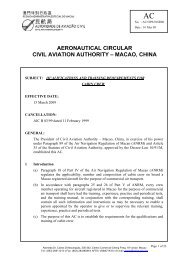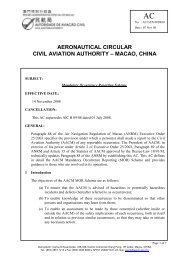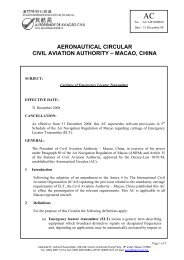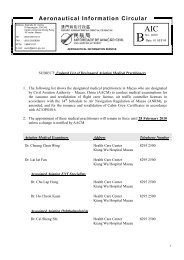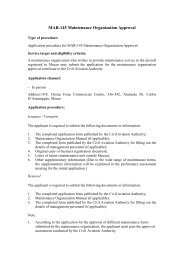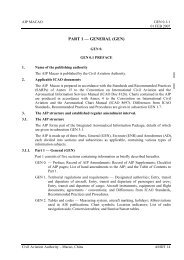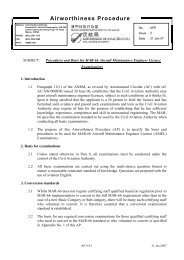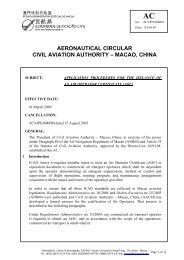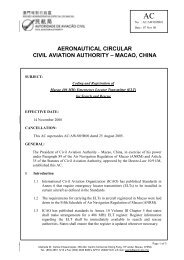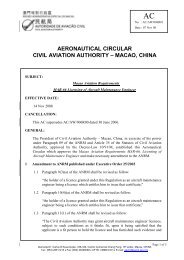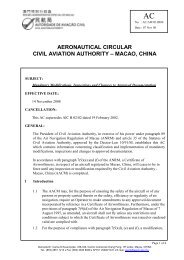Aviation Fuel at Aerodromes - Storage, Handling and Quality Control
Aviation Fuel at Aerodromes - Storage, Handling and Quality Control
Aviation Fuel at Aerodromes - Storage, Handling and Quality Control
You also want an ePaper? Increase the reach of your titles
YUMPU automatically turns print PDFs into web optimized ePapers that Google loves.
Address: Rua Dr. Pedro José, 1-3<br />
Edificio Luso Internacional,<br />
26° <strong>and</strong>ar, Macau<br />
PHONE: (853) 511213<br />
FAX: (853) 338089<br />
AFTN: VMMCYAYI<br />
Aeronautical Inform<strong>at</strong>ion Circular<br />
`<br />
AIC<br />
B<br />
No. 07/02<br />
D<strong>at</strong>e: 05 SEP 02<br />
AERONAUTICAL INFORMATION SERVICE<br />
SUBJECT: <strong>Avi<strong>at</strong>ion</strong> <strong>Fuel</strong> <strong>at</strong> <strong>Aerodromes</strong> - <strong>Storage</strong>, <strong>H<strong>and</strong>ling</strong> <strong>and</strong> <strong>Quality</strong> <strong>Control</strong><br />
1. The President of Civil <strong>Avi<strong>at</strong>ion</strong> Authority, in exercise of his power under paragraph 89 of the<br />
Air Navig<strong>at</strong>ion Regul<strong>at</strong>ion of Macau (RNAM) <strong>and</strong> Article 35 of the St<strong>at</strong>utes of Civil <strong>Avi<strong>at</strong>ion</strong><br />
Authority, approved by Decree-Law n. 10/91/M, establishes this AIC which contains<br />
inform<strong>at</strong>ion concerning avi<strong>at</strong>ion fuel install<strong>at</strong>ions <strong>at</strong> aerodromes, <strong>and</strong> fuel h<strong>and</strong>ling procedures,<br />
as detailed in Appendix 1 – <strong>Avi<strong>at</strong>ion</strong> <strong>Fuel</strong> <strong>at</strong> <strong>Aerodromes</strong> – <strong>Storage</strong>, <strong>H<strong>and</strong>ling</strong> <strong>and</strong> <strong>Quality</strong><br />
<strong>Control</strong>.<br />
2. For safety reasons, the person(s) responsible for the management of an avi<strong>at</strong>ion fuel install<strong>at</strong>ion<br />
<strong>at</strong> an aerodrome shall ensure th<strong>at</strong> on delivery fuel is of a grade appropri<strong>at</strong>e to the install<strong>at</strong>ion to<br />
which it is supplied. Also they shall ensure th<strong>at</strong> the install<strong>at</strong>ion is capable of storing <strong>and</strong><br />
dispensing fuel in a st<strong>at</strong>e fit for use in aircraft <strong>and</strong> th<strong>at</strong> the install<strong>at</strong>ion is properly marked to<br />
show the grade or grades of fuel it contains. The responsible person shall be s<strong>at</strong>isfied by<br />
sampling <strong>and</strong> testing th<strong>at</strong> the fuel is fit for use before it is delivered into an aircraft. Written<br />
records shall be kept, which show the d<strong>at</strong>es, quantities <strong>and</strong> grades of all bulk deliveries with<br />
details of all samples taken <strong>and</strong> the results of tests. Details of maintenance <strong>and</strong> cleaning shall<br />
also be recorded. These records shall be preserved for twelve months or for a longer period as<br />
required by Civil <strong>Avi<strong>at</strong>ion</strong> Authority (AACM). On request such records shall be produced to an<br />
authorized person within a reasonable time.<br />
3. This public<strong>at</strong>ion provides guidance on measures th<strong>at</strong> fuel install<strong>at</strong>ion managers should adopt in<br />
the discharge of the responsibilities placed upon them. It is aimed particularly <strong>at</strong> those<br />
install<strong>at</strong>ions managed directly by aerodrome owners or licensees, though the measures it<br />
contains are generally appropri<strong>at</strong>e to all c<strong>at</strong>egories of install<strong>at</strong>ions.<br />
4. Nothing referred to in this AIC, including its Appendix, should be construed as overriding the<br />
requirements of Decree-Law n. 19/89/M, d<strong>at</strong>ed 20 March, which should be referred to for the<br />
precise legal responsibilities placed upon fuel install<strong>at</strong>ion managers.<br />
5. For fuel <strong>and</strong> other specific<strong>at</strong>ions not mentioned in this public<strong>at</strong>ion advise should be sought from<br />
the AACM.<br />
<br />
1
Appendix 1<br />
<strong>Avi<strong>at</strong>ion</strong> <strong>Fuel</strong> <strong>at</strong> <strong>Aerodromes</strong><br />
<strong>Storage</strong>, <strong>H<strong>and</strong>ling</strong> <strong>and</strong> <strong>Quality</strong> <strong>Control</strong><br />
Appendix 1-1
Introduction ....................................................................................................................3<br />
Chapter 1 Receiving Bulk <strong>Fuel</strong> Supplies....................................................................5<br />
1 Document<strong>at</strong>ion ...............................................................................................5<br />
2 Pre-Delivery Checks ......................................................................................5<br />
3 Records...........................................................................................................6<br />
Chapter 2 <strong>Storage</strong> of <strong>Fuel</strong>s In Bulk.............................................................................7<br />
1 General ...........................................................................................................7<br />
2 Tanks ..............................................................................................................7<br />
3 Pipework.........................................................................................................8<br />
4 Filters..............................................................................................................8<br />
5 Settling Times ................................................................................................9<br />
6 Labelling <strong>and</strong> Colour Coding.........................................................................9<br />
7 Sampling <strong>and</strong> Checks ...................................................................................11<br />
8 Change of Grade Procedures........................................................................11<br />
9 Hoses ............................................................................................................11<br />
10 Labor<strong>at</strong>ory Testing of <strong>Fuel</strong> Stocks...............................................................12<br />
11 Records.........................................................................................................12<br />
Chapter 3 Aircraft <strong>Fuel</strong>ling Vehicles........................................................................13<br />
1 General .........................................................................................................13<br />
2 Sampling <strong>and</strong> Purging ..................................................................................13<br />
3 Hoses ............................................................................................................14<br />
4 Filters............................................................................................................14<br />
5 Records.........................................................................................................14<br />
Chapter 4 Hydrant Systems ......................................................................................15<br />
1 Hydrant Pits..................................................................................................15<br />
2 Low Point Drains .........................................................................................15<br />
Chapter 5 Defuelling Procedures ..............................................................................16<br />
1 Defuelling.....................................................................................................16<br />
2 Records.........................................................................................................16<br />
Chapter 6 Barrelled Supplies ....................................................................................17<br />
1 Delivery, <strong>H<strong>and</strong>ling</strong> <strong>and</strong> <strong>Storage</strong> ...................................................................17<br />
2 Sampling.......................................................................................................17<br />
3 Decanting <strong>and</strong> Dispensing............................................................................17<br />
4 Records.........................................................................................................18<br />
Chapter 7 Sampling Procedures................................................................................19<br />
1 General .........................................................................................................19<br />
2 Visual Examin<strong>at</strong>ions ....................................................................................19<br />
3 Technical Description ..................................................................................20<br />
4 Sample Containers........................................................................................20<br />
5 Sampling Procedures....................................................................................20<br />
6 Retained Samples .........................................................................................21<br />
Chapter 8 Health, Safety, Environment, Training <strong>and</strong> Emergency Procedures........22<br />
1 Safety <strong>and</strong> Training ......................................................................................22<br />
2 Reporting Accidents/Incidents .....................................................................23<br />
3 Health Hazards .............................................................................................24<br />
4 Emergency Procedures.................................................................................24<br />
5 Security.........................................................................................................25<br />
6 Spillage of <strong>Fuel</strong> ............................................................................................25<br />
Appendix 1-2
Introduction<br />
1.1 This AIC requires th<strong>at</strong> any person having management of any fuel install<strong>at</strong>ion<br />
on an aerodrome in Macao shall not permit fuel to be delivered into the<br />
install<strong>at</strong>ion or into an aircraft unless he is s<strong>at</strong>isfied th<strong>at</strong> the fuel has been<br />
sampled before it is delivered into the install<strong>at</strong>ion <strong>and</strong> it has been found by tests<br />
to be fit for use in aircraft.<br />
1.2 For each install<strong>at</strong>ion, which includes vehicles (bowsers/tankers), written records<br />
shall be made <strong>and</strong> preserved for a period of <strong>at</strong> least 12 months of particulars of<br />
all samples taken <strong>and</strong> the results of tests made on those samples.<br />
1.3 ALL FUELS TO BE USED IN AIRCRAFT REQUIRE CAREFUL<br />
HANDLING. NEGLIGENCE IN THE RECEIPT, STORAGE AND<br />
HANDLING OF FUEL OR AN ERROR IN FUELLING CAN ENDANGER<br />
AN AIRCRAFT AND THE LIVES OF ALL ON BOARD. IT IS ESSENTIAL<br />
THAT THE CORRECT GRADE AND QUANTITY OF FUEL IS SUPPLIED<br />
AND THAT IT IS IN A CONDITION FIT FOR USE IN AIRCRAFT.<br />
1.4 Certain requirements identified within this AIC may involve the use of<br />
substances <strong>and</strong>/or procedures th<strong>at</strong> may be injurious to health if adequ<strong>at</strong>e<br />
precautions are not taken. This AIC refers only to the technical suitability of fuel<br />
intended for use in aircraft <strong>and</strong> in no way absolves individuals or corpor<strong>at</strong>ions<br />
from st<strong>at</strong>utory <strong>and</strong> all other legal oblig<strong>at</strong>ions rel<strong>at</strong>ing to general welfare, health<br />
<strong>and</strong> safety.<br />
1.5 It is the responsibility of the fuel supplier to ensure th<strong>at</strong> on delivery fuel is fit for<br />
purpose. The aerodrome fuel install<strong>at</strong>ion manager should therefore, on<br />
acceptance of bulk deliveries of fuel, insist th<strong>at</strong> the supplier provides s<strong>at</strong>isfactory<br />
evidence with supporting document<strong>at</strong>ion to this effect. Such document<strong>at</strong>ion may<br />
be in the form of a Certific<strong>at</strong>e of Conformity <strong>and</strong> can be expected to give details<br />
of fuel quantity, fuel type with intern<strong>at</strong>ional st<strong>and</strong>ards <strong>and</strong> requirements<br />
acceptable by the AACM, fuel origin <strong>and</strong> b<strong>at</strong>ch references.<br />
1.6 In the case of aerodromes licensed by the AACM, the person responsible for the<br />
management of an aerodrome fuel install<strong>at</strong>ion should be appointed by the<br />
licensee. When the fuel install<strong>at</strong>ion is under the management of a fuel company,<br />
or any other organiz<strong>at</strong>ion not managed by the owner or licensees, th<strong>at</strong> company<br />
or organiz<strong>at</strong>ion should appoint the person responsible. Persons having the<br />
responsibility for the management of an aerodrome fuel install<strong>at</strong>ion must ensure<br />
th<strong>at</strong> when fuel is delivered into the install<strong>at</strong>ion it is the grade appropri<strong>at</strong>e to the<br />
tank design<strong>at</strong>ed for th<strong>at</strong> product, <strong>and</strong> th<strong>at</strong> it has been sampled <strong>and</strong> found fit for<br />
use in aircraft. After fuel has been delivered, the responsibility for its<br />
safekeeping, quality control, <strong>and</strong> proper delivery to aircraft similarly lies with<br />
this person.<br />
1.7 Reference is made in this public<strong>at</strong>ion to the recording of receipts of fuels, their<br />
sampling <strong>and</strong> testing, <strong>and</strong> maintenance <strong>and</strong> cleaning of install<strong>at</strong>ions. When<br />
delivering into or dispensing fuel from an install<strong>at</strong>ion or when carrying out fuel<br />
Appendix 1-3
checks, maintenance <strong>and</strong> cleaning oper<strong>at</strong>ions, records should be drawn up,<br />
signed <strong>and</strong> d<strong>at</strong>ed by the person responsible on completion of such work.<br />
1.8 It is for managers of install<strong>at</strong>ions to decide the form the records should take, but<br />
it is obviously important th<strong>at</strong> they are kept in such a way as to maintain their<br />
legibility.<br />
1.9 If it appears to the AACM th<strong>at</strong> any avi<strong>at</strong>ion fuel is intended or likely to be<br />
delivered in contravention of any provision of this AIC, the AACM may direct<br />
the person having the management of the install<strong>at</strong>ion not to permit avi<strong>at</strong>ion fuel<br />
to be dispensed from th<strong>at</strong> install<strong>at</strong>ion until the direction has been revoked by the<br />
AACM.<br />
1.10 For the purpose of this public<strong>at</strong>ion ‘avi<strong>at</strong>ion fuel’ means fuel intended for use in<br />
aircraft; ‘avi<strong>at</strong>ion fuel install<strong>at</strong>ion’ means any appar<strong>at</strong>us or container, including<br />
a vehicle, designed, manufactured or adapted for the storage of avi<strong>at</strong>ion fuel or<br />
for the delivery of such fuel to an aircraft.<br />
1.11 When required by the comm<strong>and</strong>er of an aircraft receiving fuel, the manager of<br />
the fuel install<strong>at</strong>ion shall provide a written st<strong>at</strong>ement of the quantity <strong>and</strong> grade of<br />
fuel supplied.<br />
Appendix 1-4
Chapter 1 Receiving Bulk <strong>Fuel</strong> Supplies<br />
1 Document<strong>at</strong>ion<br />
<strong>Avi<strong>at</strong>ion</strong> fuel should be delivered by a dedic<strong>at</strong>ed system. If this is not the case then<br />
special precautions not covered in this document are necessary <strong>and</strong> advice should be<br />
sought from the AACM before accepting deliveries of fuel.<br />
1.1 Document<strong>at</strong>ion should clearly st<strong>at</strong>e the type of fuel being supplied, <strong>and</strong> th<strong>at</strong> it<br />
complies with the relevant specific<strong>at</strong>ions: Jet A-1 should comply with DEF<br />
STAN 91–91 or ASTM D 1655 <strong>and</strong> AVGAS with DEF STAN 91–90 or ASTM<br />
D 910. Jet A–1 containing <strong>Fuel</strong> System Icing Inhibitor (FSII) may also be<br />
dispensed, particularly <strong>at</strong> aerodromes used primarily by helicopters: this fuel<br />
should comply with DEF STAN 91–87.<br />
1.2 On delivery of fuel, the person in charge of the install<strong>at</strong>ion will normally be<br />
required by the supplier to endorse the Certific<strong>at</strong>e of Conformity/Release Note<br />
to confirm th<strong>at</strong> the grade of fuel is as ordered.<br />
2 Pre-Delivery Checks<br />
2.1 Before the release document<strong>at</strong>ion is accepted <strong>and</strong> delivery permitted, the person<br />
responsible for receiving the fuel should:<br />
a) Check th<strong>at</strong> the grade <strong>and</strong> quantity as shown on the certific<strong>at</strong>e are as ordered,<br />
<strong>and</strong> correspond with the grade of fuel in the receiving tank.<br />
b) Examine the seals on the delivery vehicle or vessel <strong>and</strong> ensure they are<br />
intact. Also check the vehicle or vessel grade pl<strong>at</strong>e indic<strong>at</strong>or.<br />
c) Check there is sufficient available capacity in the receiving tank(s) for the<br />
quantity of fuel to be received.<br />
d) Sample <strong>and</strong> test the fuel in the receiving tank(s) for the presence of w<strong>at</strong>er in<br />
accordance with the procedures detailed in Chapter 7. If necessary flush the<br />
w<strong>at</strong>er drains until a clear <strong>and</strong> w<strong>at</strong>er-free sample is obtained.<br />
e) Allow the delivery vehicle to st<strong>and</strong> on level ground for ten minutes, then<br />
draw a sample from the outlet tap of each vehicle compartment from which<br />
fuel is to be delivered <strong>and</strong> check in accordance with the procedures detailed<br />
in Chapter 7, para 5.3 <strong>and</strong> 5.4.<br />
f) Repe<strong>at</strong> the procedure in para. 2.1(e) if the sample is uns<strong>at</strong>isfactory. If a third<br />
sample is necessary <strong>and</strong> this also proves to be uns<strong>at</strong>isfactory, delivery of the<br />
fuel should be refused <strong>and</strong> the fuel supplier informed.<br />
2.2 Once a s<strong>at</strong>isfactory visual sample <strong>and</strong> density result (see note below) have been<br />
obtained, the vehicle should be bonded to an approved earthing point <strong>and</strong><br />
discharge of fuel commenced into the selected <strong>and</strong> correctly grade-pl<strong>at</strong>ed<br />
receiving point.<br />
NOTE:If on delivery it is considered necessary to determine the density of the<br />
fuel then the density should not vary by more than 0.003 kg/litre (when<br />
measured <strong>at</strong> 15°C) from the value quoted on the delivery note.<br />
Appendix 1-5
2.3 On completion of the fuel delivery, record the results of the pre-delivery<br />
inspection <strong>and</strong> sample tests. Also record the quantity <strong>and</strong> grade of fuel delivered.<br />
2.4 All samples of fuel taken should be retained for a minimum of seven days. See<br />
Chapter 7. In the case of aerodromes where there is a large turnover of fuel these<br />
reference samples may be held by the fuel company delivering the fuel.<br />
3 Records<br />
Records should be kept of all deliveries both to <strong>and</strong> from install<strong>at</strong>ions. These records<br />
should show the results of the actions listed in paragraph 2 above <strong>and</strong> include details<br />
of the checks <strong>and</strong> items listed below:<br />
a) The results of sampling, w<strong>at</strong>er drain checks, differential pressure, filter <strong>and</strong><br />
flo<strong>at</strong>ing suction head checks.<br />
b) Details of incoming consignments with cross reference to release<br />
notes/certific<strong>at</strong>es of conformity.<br />
c) Receiving tank contents <strong>and</strong> w<strong>at</strong>er check, settling times <strong>and</strong> release checks.<br />
d) Filtr<strong>at</strong>ion equipment – to include results of filter element, differential<br />
pressure <strong>and</strong> w<strong>at</strong>er checks.<br />
e) Label <strong>and</strong> retain fuel samples. See Chapter 7.<br />
f) Records shall include details of consequential action where an inspection,<br />
sampling or test has revealed a defect or deficiency.<br />
Appendix 1-6
Chapter 2 <strong>Storage</strong> of <strong>Fuel</strong>s In Bulk<br />
1 General<br />
1.1 All facilities which are used for h<strong>and</strong>ling avi<strong>at</strong>ion fuel must be fully segreg<strong>at</strong>ed<br />
from other products. Different grades of avi<strong>at</strong>ion fuels must also be segreg<strong>at</strong>ed.<br />
Ideally install<strong>at</strong>ions should have separ<strong>at</strong>e delivery <strong>and</strong> suction lines <strong>and</strong> these<br />
should be provided on all new install<strong>at</strong>ions.<br />
1.2 The use of protective tre<strong>at</strong>ments containing zinc is prohibited for the internal<br />
lining of pipelines, storage tanks <strong>and</strong> any other equipment. Zinc alloys, copper<br />
or copper alloys, cadmium pl<strong>at</strong>ing, galvanised steel <strong>and</strong> plastic m<strong>at</strong>erials should<br />
not be used for main piping.<br />
2 Tanks<br />
2.1 Tanks should be constructed <strong>and</strong> installed so as to prevent the ingress of w<strong>at</strong>er<br />
<strong>and</strong> dirt. They should have a well defined low point. To achieve this horizontal<br />
tanks should have a minimum slope of 1:30 with a sump <strong>at</strong> the lowest point.<br />
Vertical tanks should have a cone-down bottom with a minimum 1:30 slope to a<br />
center sump.<br />
2.2 When tanks are buried, the manhole chamber/cover should always be kept clean<br />
<strong>and</strong> clear of w<strong>at</strong>er.<br />
2.3 Jet A-1 storage tanks should have free vent devices. AVGAS tanks should have<br />
pressure/vacuum relief valves, unless the tank is underground.<br />
2.4 All possible precautions should be taken to avoid the entry of w<strong>at</strong>er or dirt into<br />
storage tanks. Open ended pipes, hoses <strong>and</strong> sampling points should be fitted<br />
with dust caps, plugs or other suitable protection which should be replaced<br />
tightly after use.<br />
2.5 Provision should be made for withdrawing w<strong>at</strong>er from the lowest points of<br />
tanks. Therefore above ground tanks should be fitted with a drain cock <strong>at</strong> the<br />
lowest tank point. Buried tanks should be provided with a thief pump drawing<br />
from the tank sump.<br />
2.6 Samples which have been tested <strong>and</strong> indic<strong>at</strong>ed th<strong>at</strong> the fuel may be contamin<strong>at</strong>ed<br />
are an indic<strong>at</strong>ion th<strong>at</strong> the integrity of the install<strong>at</strong>ion should be investig<strong>at</strong>ed<br />
immedi<strong>at</strong>ely. If frequent evidence of contamin<strong>at</strong>ion is found the tank should be<br />
internally inspected <strong>and</strong> cleaned.<br />
2.7 Tanks should be internally inspected <strong>at</strong> least once a year <strong>and</strong> internally manually<br />
cleaned every three years. A newly lined tank should be inspected one year after<br />
the lining is installed to check for soundness <strong>and</strong> adherence to the tank shell.<br />
Defects should be rectified before the tank is refilled.<br />
2.8 It is recommended th<strong>at</strong> all fuel tanks should be co<strong>at</strong>ed with a suitable lining. A<br />
specific<strong>at</strong>ion for tank linings is available from the fuel suppliers.<br />
Appendix 1-7
2.9 The use of a flo<strong>at</strong>ing suction fitted with a stainless steel check cable is<br />
recommended for the delivery of fuel from storage tanks. Check chains should<br />
not be used. Whether fixed or flo<strong>at</strong>ing systems are used, the suction point should<br />
be positioned well clear of the tank sump, <strong>and</strong> in the case of a fixed suction <strong>at</strong><br />
least 50 cm clear of the tank bottom.<br />
3 Pipework<br />
3.1 To ensure the integrity of fuels it is essential th<strong>at</strong> each grade of fuel is h<strong>and</strong>led in<br />
a completely segreg<strong>at</strong>ed system with no interconnecting lines between pipelines<br />
which h<strong>and</strong>le different grades of fuel. Separ<strong>at</strong>e input <strong>and</strong> outlet lines should be<br />
provided.<br />
3.2 Drain points should be fitted <strong>at</strong> all pipeline low points.<br />
4 Filters<br />
4.1 Avgas Install<strong>at</strong>ions: Tank input <strong>and</strong> output lines should be fitted with filters of<br />
not less than 80 microns (180 mesh). Also a 5 micron filter should be fitted on<br />
the output line. 80-micron filters should be inspected weekly <strong>and</strong> cleaned if<br />
necessary. Damaged filters should be repaired or replaced.<br />
4.2 <strong>Avi<strong>at</strong>ion</strong> turbine fuel install<strong>at</strong>ions: Tank input lines should be fitted with a 5-<br />
micron microfilter, or a filter separ<strong>at</strong>or. The output line should also be fitted<br />
with a filter separ<strong>at</strong>or. Filter separ<strong>at</strong>ors should have a nominal r<strong>at</strong>ing of 5<br />
microns for solid particles <strong>and</strong> a maximum of l5 parts per million for w<strong>at</strong>er.<br />
4.3 Filter separ<strong>at</strong>ors, filter monitors <strong>and</strong> microfilters should have the differential<br />
pressure (dp) checked weekly. The check should be completed <strong>at</strong> the maximum<br />
possible flow r<strong>at</strong>e <strong>and</strong> the pressure readings recorded. Filter separ<strong>at</strong>or elements<br />
should be changed when the dp limit <strong>at</strong> the r<strong>at</strong>ed vessel flow as recommended<br />
by the manufacturer is reached (usually 1 bar or 15 psi), or after a maximum<br />
period of in-service use of three years.<br />
4.4 Where a sudden or significant change of dp from the previously recorded trend<br />
is detected, the elements of microfilters or filter separ<strong>at</strong>ors should be checked.<br />
They should also be inspected <strong>and</strong> replaced if necessary when a significant<br />
reduction in flow r<strong>at</strong>e is observed or when a sequence of uns<strong>at</strong>isfactory drain<br />
samples is obtained.<br />
4.5 It is recommended th<strong>at</strong> quarterly millipore colour <strong>and</strong> millipore gravimetric<br />
checks are taken to assess the performance of the filtr<strong>at</strong>ion equipment. This<br />
check is particularly relevant where fuel flow r<strong>at</strong>es exceed 1150 litres/min.<br />
4.6 When initially filling a filter separ<strong>at</strong>or vessel the fuel flow should be regul<strong>at</strong>ed<br />
to prevent an excessive build up of st<strong>at</strong>ic electricity.<br />
4.7 Jet A-1 is a very good insul<strong>at</strong>or. Jet A-1 supplied within Macao may contain a<br />
st<strong>at</strong>ic dissip<strong>at</strong>or additive which reduces st<strong>at</strong>ic electricity hazard. <strong>Fuel</strong> suppliers<br />
will advise whether fuel contains this additive. Suppliers may also provide<br />
advice on oper<strong>at</strong>ing procedures <strong>and</strong> engineering safeguards which can be<br />
adopted to minimise st<strong>at</strong>ic electricity hazards.<br />
Appendix 1-8
5 Settling Times<br />
5.1 On completion of delivery, before avi<strong>at</strong>ion fuel is dispensed from the receiving<br />
tank, fuel should be allowed to settle for a period of time which depends on the<br />
grade <strong>and</strong> depth of fuel in the tank. The settling time is also dependent on the<br />
type of tank, filter arrangement <strong>and</strong> the method by which fuel is drawn from the<br />
tanks.<br />
5.2 When discharge of fuel from the delivery vehicle or vessel has commenced, no<br />
fuel should be dispensed from the receiving tank until adequ<strong>at</strong>e settling time has<br />
elapsed <strong>and</strong> the s<strong>at</strong>isfactory completion of the w<strong>at</strong>er <strong>and</strong> fuel cleanliness check<br />
carried out in accordance with the procedures details in Chapter 7.<br />
5.3 Horizontal tanks fitted with flo<strong>at</strong>ing suction devices require a minimum settling<br />
time of one hour per meter depth. Vertical tanks similarly equipped require a<br />
settling time of two hours per meter depth.<br />
5.4 On tanks where flo<strong>at</strong>ing suctions are not provided or where flo<strong>at</strong>ing suction lines<br />
are used but not fitted with the filter arrangements mentioned in para 4.1 <strong>and</strong> 4.2<br />
above, the following minimum settling times, dependent on fuel grade stored,<br />
should be required:<br />
Jet A-1: 3 hours per meter depth or 24 hours, whichever is less;<br />
AVGAS: 90 minutes per meter depth.<br />
6 Labelling <strong>and</strong> Colour Coding<br />
6.1 Marking of aerodrome equipment for fuel identific<strong>at</strong>ion<br />
All aerodrome equipment should be marked to identify the type <strong>and</strong> grade of avi<strong>at</strong>ion<br />
fuel being issued <strong>and</strong> dispensed in order to preclude intermixing or contamin<strong>at</strong>ing the<br />
fuels.<br />
1. <strong>Fuel</strong>ling system<br />
Aerodrome fuelling systems should be marked utilizing the marking code<br />
described in paragraph 6.2.<br />
a. <strong>Fuel</strong> tanks should be marked with letters <strong>at</strong> least 3 inches high to<br />
identify type <strong>and</strong> grade of fuel.<br />
b. Piping should be marked with letters <strong>at</strong> least 3 inches high <strong>and</strong> colour<br />
coded as required.<br />
2. <strong>Fuel</strong>ling vehicles<br />
To prevent error in identific<strong>at</strong>ion of fuels in fuelling vehicles, marking as<br />
described in paragraph 6.2, with white letters <strong>at</strong> least 3 inches high, should<br />
be painted <strong>at</strong> the hose outlet <strong>and</strong> the grade label of fuel should be painted<br />
on vehicles <strong>at</strong> loc<strong>at</strong>ion for easy identific<strong>at</strong>ion.<br />
Appendix 1-9
6.2 Labelling <strong>and</strong> Colour Coding<br />
A labelling <strong>and</strong> colour coding should be used to permit rapid identific<strong>at</strong>ion under<br />
varying visibility conditions. All tanks should be labelled <strong>and</strong> colour coded to identify<br />
the grade of fuel they contain. Pipelines should also be similarly labelled <strong>and</strong> colour<br />
coded. The form <strong>and</strong> requirements of labelling <strong>and</strong> colour coding are illustr<strong>at</strong>ed in<br />
Table 1.<br />
1. <strong>Avi<strong>at</strong>ion</strong> Gasoline:<br />
a. The grade label for avi<strong>at</strong>ion gasoline is printed in white letters <strong>and</strong><br />
numbers on a red background.<br />
b. The colour of the single b<strong>and</strong> around the piping or hose is the same<br />
colour as the dye in the grade of AVGAS flowing through the line.<br />
They are red for AVGAS 80, blue for AVGAS 100LL <strong>and</strong> green for<br />
AVGAS 100. A minimum 4-inch wide b<strong>and</strong> is recommended. If the<br />
pipeline is painted the colour of the AVGAS, then no b<strong>and</strong>ing is<br />
needed.<br />
2. Jet <strong>Fuel</strong>:<br />
a. The grade label for jet fuel is painted in white letters on a black<br />
background.<br />
b. Two 4-inch wide (minimum) black b<strong>and</strong>s around the piping or hose are<br />
used to identify JET A-1.<br />
Table 1: Labelling <strong>and</strong> Colour Coding - <strong>Avi<strong>at</strong>ion</strong> Gasoline <strong>and</strong> Jet <strong>Fuel</strong><br />
PRODUCT BANDING MARKING<br />
AVGAS 100<br />
1 Green<br />
AVGAS 100 LL<br />
1 Blue<br />
AVGAS 80<br />
1 Red<br />
JET A-1<br />
2 Black<br />
Appendix 1-10
7 Sampling <strong>and</strong> Checks<br />
7.1 <strong>Storage</strong> tanks should be constructed or adapted so as to allow upper, middle <strong>and</strong><br />
lower samples to be taken. These samples, taken through the depth of the tank,<br />
may be required from time to time for analysis.<br />
7.2 Sampling, in accordance with the procedures detailed in Chapter 7 should be<br />
carried out <strong>at</strong> the following times:<br />
a) each day before the first delivery from the tanks;<br />
b) immedi<strong>at</strong>ely before receipt of fuel into tanks;<br />
c) after receipt when the fuel has been allowed to settle for the recommended<br />
period;<br />
d) after prolonged heavy rain or snow.<br />
NOTE: Line flushing should always be sufficient to ensure th<strong>at</strong> a proper tank<br />
sample is obtained<br />
7.3 If a sample identifies the presence of w<strong>at</strong>er or sediment, a further sample should<br />
be taken. No fuel should be dispensed from a tank until a clear <strong>and</strong> bright<br />
sample has been obtained.<br />
7.4 Should a fuel sample reveal large quantities of w<strong>at</strong>er, dirt or slime, or should the<br />
fuel be discoloured the tank should be quarantined until the source of<br />
contamin<strong>at</strong>ion is identified <strong>and</strong> remedial action completed.<br />
7.5 S<strong>at</strong>isfactory samples may be returned to storage to avoid waste of fuel. If<br />
contamin<strong>at</strong>ed, samples should not be returned to any part of the avi<strong>at</strong>ion fuelling<br />
system unless the contamin<strong>at</strong>ion has completely settled out <strong>and</strong> been removed. It<br />
is good practice for install<strong>at</strong>ions to have a product recovery (slops) tank for each<br />
grade of fuel. Product recovery tanks should be tre<strong>at</strong>ed in the same way, in terms<br />
of w<strong>at</strong>er draining, as the main storage tanks.<br />
7.6 Buoyancy of flo<strong>at</strong>ing suctions should be checked <strong>at</strong> least weekly by the<br />
oper<strong>at</strong>ion of the check wire. Check wires should be secured <strong>and</strong> bonded to the<br />
tank shell.<br />
8 Change of Grade Procedures<br />
Change of fuel grade in storage tanks can pose a risk of contamin<strong>at</strong>ion of the new<br />
grade by residues of the previous fuel stored <strong>and</strong> therefore, where possible, such<br />
changes should be avoided. If this is not practicable, it is recommended th<strong>at</strong> guidance<br />
on the proper procedures should be obtained from the fuel supplier concerned.<br />
Additional inform<strong>at</strong>ion on this oper<strong>at</strong>ion can be found in DEF STAN 91-66.<br />
9 Hoses<br />
9.1 Hoses shall comply with the requirements of BS EN1361 (1997). New hoses,<br />
<strong>and</strong> hoses previously used in avi<strong>at</strong>ion fuel systems, should be checked <strong>and</strong><br />
Appendix 1-11
efore use thoroughly flushed with fuel appropri<strong>at</strong>e to the install<strong>at</strong>ion. Hoses<br />
which have been used previously for non-avi<strong>at</strong>ion fuels should not be used on<br />
avi<strong>at</strong>ion fuel install<strong>at</strong>ions.<br />
9.2 <strong>Fuel</strong> in delivery hoses should be recircul<strong>at</strong>ed if the delivery system has been<br />
unused for a period of two days. If a delivery system has been unused for longer<br />
than this period, then fuel lying in a hose should not be recircul<strong>at</strong>ed or dispensed<br />
to aircraft unless a s<strong>at</strong>isfactory sampling check in accordance with the<br />
procedures in Chapter 7 is obtained.<br />
10 Labor<strong>at</strong>ory Testing of <strong>Fuel</strong> Stocks<br />
10.1 <strong>Fuel</strong> deterior<strong>at</strong>es with time <strong>and</strong> prolonged storage may render it unfit for use in<br />
aircraft. Therefore the quality of st<strong>at</strong>ic bulk stocks of avi<strong>at</strong>ion fuels should be<br />
verified by labor<strong>at</strong>ory tests when:<br />
a) Jet A-1 has been stored <strong>and</strong> not added to for a period of twelve months;<br />
b) AVGAS has been stored <strong>and</strong> not added to for a period of six months.<br />
10.2 The quality of avi<strong>at</strong>ion fuel stored in either a tank commissioned for use from<br />
new, or stored in a tank which has been reintroduced to service after cleaning<br />
requires verific<strong>at</strong>ion by labor<strong>at</strong>ory test.<br />
10.3 The companies supplying fuel can provide inform<strong>at</strong>ion on recognised<br />
labor<strong>at</strong>ories th<strong>at</strong> can undertake these tests.<br />
10.4 In any event, where the suitability of avi<strong>at</strong>ion fuel is in doubt, a full specific<strong>at</strong>ion<br />
test to the relevant st<strong>and</strong>ards may be conducted if a 5 litre sample of the fuel is<br />
available. If this is not possible, then sufficient d<strong>at</strong>a may be obtained from the<br />
results of the following tests, for which a 2.5 litre sample is the minimum<br />
required: appearance, density <strong>at</strong> 15°C, distill<strong>at</strong>ion, copper strip corrosion,<br />
freezing point, existent gum, flash point, w<strong>at</strong>er reaction, electrical conductivity<br />
<strong>and</strong> thermal stability.<br />
11 Records<br />
Records should be kept of all deliveries into <strong>and</strong> from an install<strong>at</strong>ion. The results of<br />
sampling, filter differential pressure readings, purging <strong>and</strong> flo<strong>at</strong>ing suction checks<br />
should be recorded. A record of tank inspections tank cleaning <strong>and</strong> maintenance work<br />
should also be kept.<br />
Appendix 1-12
Chapter 3 Aircraft <strong>Fuel</strong>ling Vehicles<br />
1 General<br />
1.1 All fuelling vehicle equipment should be constructed of either aluminium alloy,<br />
stainless steel or mild steel protected internally with an epoxy lining. Zinc <strong>and</strong><br />
copper alloys, cadmium pl<strong>at</strong>ing, galvanised steel or plastic m<strong>at</strong>erials are not<br />
permitted.<br />
1.2 Grade identific<strong>at</strong>ion labels of the type illustr<strong>at</strong>ed in Chapter 2, para 6 should be<br />
carried in prominent positions on fuelling vehicles. <strong>Fuel</strong> inlets <strong>and</strong> outlets<br />
including hoses <strong>and</strong> nozzles should be marked accordingly.<br />
1.3 Tank compartments, whether lined or unlined, should be kept clean <strong>and</strong><br />
precautions taken to prevent the entry of contaminants. All open-ended hoses,<br />
pipes <strong>and</strong> sampling points should be fitted with dust caps, plugs or other suitable<br />
protection which should be properly replaced after use.<br />
1.4 Tank compartments should be designed so as to drain to a low point sump fitted<br />
with a drain line valve. Drain lines should have a constant downward slope with<br />
a drain plug fitted <strong>at</strong> the lowest point overall which will permit complete<br />
draining of the tank install<strong>at</strong>ion.<br />
1.5 Tank compartments should be drained <strong>and</strong> inspected internally within a twelve<br />
monthly inspection cycle. Cleaning <strong>and</strong> repair work, when necessary, should be<br />
completed during these periodic inspections.<br />
1.6 Where fuelling vehicles draw fuel from aerodrome install<strong>at</strong>ions which h<strong>and</strong>le<br />
both Jet A-l <strong>and</strong> AVGAS, all line couplings should be grade selective. A<br />
fuelling vehicle should carry only one grade of fuel.<br />
1.7 Change of fuel grade in vehicle tanks can pose a risk of contamin<strong>at</strong>ion of the<br />
new grade by residues of the previous fuel carried, therefore, where possible,<br />
such changes should be avoided. If this is not practicable, it is recommended<br />
th<strong>at</strong> guidance on the proper procedures should be obtained from the fuel supplier<br />
concerned.<br />
Additional inform<strong>at</strong>ion on this procedure can be found in DEF STAN 91-66.<br />
2 Sampling <strong>and</strong> Purging<br />
2.1 All fuelling equipment (drain cocks, tank compartments, filter separ<strong>at</strong>ors, filter<br />
monitors, microfilters, gauze filters <strong>and</strong> air separ<strong>at</strong>ors) should be purged of<br />
w<strong>at</strong>er <strong>and</strong> sediment<br />
a) before the first aircraft refuelling each day;<br />
b) after each filling of the vehicle <strong>and</strong> after defuelling;<br />
c) after vehicle washing, prolonged heavy rainfall or snow.<br />
2.2 After a refueller has been filled, samples should not be taken until l0 minutes<br />
settling time has been allowed. No deliveries either from or into the vehicle<br />
Appendix 1-13
should be made until s<strong>at</strong>isfactory samples are obtained. If uns<strong>at</strong>isfactory samples<br />
continue to be obtained, action must be taken to identify <strong>and</strong> elimin<strong>at</strong>e the cause.<br />
S<strong>at</strong>isfactory samples may be returned to storage.<br />
(Recommended sampling <strong>and</strong> checking procedures are explained in detail in<br />
Chapter 7)<br />
3 Hoses<br />
3.1 Hoses shall comply with the requirements of BS EN 1361. New hoses, <strong>and</strong><br />
hoses previously used in avi<strong>at</strong>ion fuel systems, should be checked <strong>and</strong> before<br />
use thoroughly flushed with fuel appropri<strong>at</strong>e to the install<strong>at</strong>ion. Hoses which<br />
have been used previously for non-avi<strong>at</strong>ion fuels must not be used on avi<strong>at</strong>ion<br />
fuel install<strong>at</strong>ions.<br />
3.2 <strong>Fuel</strong> in delivery hoses should be recircul<strong>at</strong>ed if the delivery system has been<br />
unused for a period of two days. If a delivery system has been unused for longer<br />
than this period, then the fuel lying in a hose should not be recircul<strong>at</strong>ed or<br />
dispensed to aircraft unless a s<strong>at</strong>isfactory sampling check in accordance with the<br />
procedures in Chapter 7 is obtained.<br />
4 Filters<br />
4.1 All fuelling vehicles containing AVGAS should be fitted with a 5 micron filter.<br />
Vehicles containing Jet A-1 should be fitted with a filter separ<strong>at</strong>or or monitor<br />
with a 5 micron r<strong>at</strong>ing.<br />
4.2 150 micron (100 mesh) r<strong>at</strong>ing hose end filters should be fitted which should be<br />
inspected <strong>at</strong> least once monthly <strong>and</strong> if necessary, cleaned, repaired or replaced.<br />
Excessive contamin<strong>at</strong>ion of a hose <strong>and</strong> filter may indic<strong>at</strong>e deterior<strong>at</strong>ion of the<br />
hose in which case the hose should be replaced.<br />
4.3 Differential pressure checks taken <strong>at</strong> the maximum flow r<strong>at</strong>e should be made on<br />
microfilters, filter separ<strong>at</strong>ors <strong>and</strong> filter monitors <strong>at</strong> weekly intervals.<br />
4.4 Micro filters <strong>and</strong> filter separ<strong>at</strong>or elements should be changed when the dp<br />
reaches the limit recommended by the manufacturer (normally 1 bar or 15 psi).<br />
4.5 Filter monitor type elements should be replaced after a maximum of three years<br />
use or when the dp reaches 1.5 bar or 22 psi.<br />
4.6 Should a sudden or significant change from the previous trend of differential<br />
pressures occur, the elements should also be inspected to ensure they are<br />
functioning correctly. Filter elements should also be inspected <strong>and</strong> changed if<br />
necessary if a significant reduction in flow is detected or continuing<br />
uns<strong>at</strong>isfactory drain samples are obtained.<br />
5 Records<br />
Records should be kept of all fuel deliveries both into <strong>and</strong> from vehicles together with<br />
the results of sampling differential pressure, purging <strong>and</strong> filter checks. Results of tank<br />
inspections should also be recorded along with a record of all rectific<strong>at</strong>ion <strong>and</strong><br />
maintenance work. Details of hose inspections should also be kept.<br />
Appendix 1-14
Chapter 4 Hydrant Systems<br />
1 Hydrant Pits<br />
1.1 Hydrant pits should be kept clean <strong>and</strong> dry <strong>at</strong> all times. Inspections should be<br />
made <strong>at</strong> regular intervals.<br />
1.2 Hydrant pit covers should be secured to pits by a suitable means.<br />
1.3 If a pit is not used for a period of three months or more, the contents of the spur<br />
line should be flushed.<br />
1.4 Hydrant pits should be marked with identific<strong>at</strong>ion <strong>and</strong> should also show the<br />
appropri<strong>at</strong>e fuel grade labelling <strong>and</strong> colour coding referred to in Chapter 2 para<br />
6.<br />
2 Low Point Drains<br />
2.1 All low points on a hydrant system should be fitted with a low point drain.<br />
2.2 All low point drains should be flushed thoroughly with the line under pressure <strong>at</strong><br />
least once a week, to ensure the removal of any w<strong>at</strong>er or sediment, until a clear<br />
<strong>and</strong> bright sample is obtained.<br />
2.3 If excessive w<strong>at</strong>er or dirt is found the reason must be identified <strong>and</strong> elimin<strong>at</strong>ed<br />
before further supplies of fuel are dispensed to aircraft.<br />
Appendix 1-15
Chapter 5 Defuelling Procedures<br />
1 Defuelling<br />
1.1 When an aircraft is to be defuelled, whether in total or in part, instructions on<br />
the disposal of the fuel should be obtained from the aircraft oper<strong>at</strong>or. <strong>Fuel</strong> must<br />
not be returned to aircraft tanks unless s<strong>at</strong>isfactory quality checks are obtained.<br />
1.2 The acceptance of fuel from aircraft into fuelling vehicles or aerodrome storage<br />
tanks can introduce the following two hazards to quality:<br />
a) w<strong>at</strong>er, other liquid or sediment from the aircraft tanks may be introduced<br />
into vehicle or storage tanks;<br />
b) fuel taken from aircraft tanks, <strong>and</strong> any resultant blend with existing contents<br />
of the vehicle or storage tanks, may not meet the appropri<strong>at</strong>e product<br />
specific<strong>at</strong>ion.<br />
1.3 The above mentioned hazards will be avoided by defuelling into an empty<br />
fuelling vehicle or an empty storage tank segreg<strong>at</strong>ed from other parts of the<br />
install<strong>at</strong>ion. Before defuelling is commenced, samples should be taken from the<br />
drain cocks of each aircraft tank involved in the defuelling oper<strong>at</strong>ion.<br />
Uns<strong>at</strong>isfactory samples do not preclude defuelling but will call for particular<br />
<strong>at</strong>tention <strong>and</strong> thoroughness in the cleaning of vehicles <strong>and</strong> tank install<strong>at</strong>ion after<br />
disposal of the fuel.<br />
2 Records<br />
Records of all defuelling oper<strong>at</strong>ions are required. They should include the registr<strong>at</strong>ion<br />
of the aircraft involved, the results of sampling checks <strong>and</strong> the quantity <strong>and</strong> grade of<br />
fuel drawn. Record should also be made of the fuel disposal.<br />
Appendix 1-16
Chapter 6 Barrelled Supplies<br />
1 Delivery, <strong>H<strong>and</strong>ling</strong> <strong>and</strong> <strong>Storage</strong><br />
1.1 A barrel is generally considered to be a container having a capacity less than 210<br />
litres. Barrels storing avi<strong>at</strong>ion fuel should be distinctly coloured according to<br />
grade.<br />
1.2 Before acceptance, barrels should be examined for damage <strong>and</strong> seal integrity.<br />
Grade marking <strong>and</strong> inspector's identific<strong>at</strong>ion should cross check with details on<br />
the delivery note <strong>and</strong> release certific<strong>at</strong>e.<br />
1.3 Barrels should be stored under cover, clear of the ground <strong>and</strong> on their sides with<br />
both bungs below the liquid level.<br />
1.4 A storage system should be adopted th<strong>at</strong> will use the oldest fuel first, according<br />
to b<strong>at</strong>ch number <strong>and</strong> filling d<strong>at</strong>e.<br />
1.5 Different grades of fuel should be separ<strong>at</strong>ed from each other to minimise the risk<br />
of fuelling error.<br />
1.6 B<strong>at</strong>ches of AVGAS require labor<strong>at</strong>ory testing six months after the filling d<strong>at</strong>e<br />
with periodic six monthly checks thereafter. For Jet A-1 the testing period is<br />
every twelve months. After sampling the barrels must be resealed.<br />
2 Sampling<br />
2.1 Before sampling, check th<strong>at</strong> the seals are intact then st<strong>and</strong> the barrel on end <strong>and</strong><br />
wipe clean the area adjacent to the bung. Allow the contents to settle before<br />
drawing off the required quantity of fuel. Sampling procedures should be in<br />
accordance with Chapter 7.<br />
2.2 Discolour<strong>at</strong>ion of the fuel, or the presence of w<strong>at</strong>er or dirt in the sample<br />
indic<strong>at</strong>es th<strong>at</strong> the fuel is unfit for avi<strong>at</strong>ion use <strong>and</strong> therefore the barrel must be<br />
rejected.<br />
3 Decanting <strong>and</strong> Dispensing<br />
3.1 <strong>Fuel</strong> should preferably be decanted from barrels into fuelling vehicles or storage<br />
by means of a suitable pump <strong>and</strong> lines fitted with a microfilter or filter separ<strong>at</strong>or.<br />
AVGAS may altern<strong>at</strong>ively be decanted through a funnel fitted with an 80<br />
micron filter.<br />
3.2 When it is necessary to dispense fuel direct from barrel to aircraft, the barrels<br />
should be stood on end <strong>and</strong> the contents allowed to settle for ten minutes before<br />
taking samples. Once a s<strong>at</strong>isfactory sample has been obtained fuel may then be<br />
dispensed to the aircraft tanks through a suction st<strong>and</strong>pipe designed so th<strong>at</strong> fuel<br />
cannot be drawn from below a depth of 75mm from the barrel bottom.<br />
3.3 Delivery of AVGAS or JET A-1 to an aircraft should be via a filter monitor type<br />
element or equivalent filter. Additionally, Jet A-1 delivery should be through a<br />
Appendix 1-17
microfilter or filter separ<strong>at</strong>or. Specific<strong>at</strong>ions are given in Chapter 2 para 4.<br />
<strong>Fuel</strong>ling hoses should comply with BS EN 1361.<br />
3.4 After decanting or dispensing fuel, replace barrel caps tightly <strong>and</strong> reseal.<br />
3.5 After use, drums should not be re-filled with fuel intended for avi<strong>at</strong>ion purposes.<br />
It is recommended th<strong>at</strong> when emptied barrels should be returned to the fuel<br />
supplier.<br />
4 Records<br />
Records should be kept of all barrel deliveries, decanting <strong>and</strong> dispensing of fuel, <strong>and</strong><br />
sampling checks.<br />
Appendix 1-18
Chapter 7 Sampling Procedures<br />
1 General<br />
1.1 During the h<strong>and</strong>ling <strong>and</strong> storage of avi<strong>at</strong>ion fuels sampling checks will be<br />
required to ensure th<strong>at</strong> fuel intended for use is in a fit st<strong>at</strong>e for th<strong>at</strong> purpose.<br />
1.2 The aerodrome licensee shall arrange for adequ<strong>at</strong>e sampling of a sufficient<br />
portion of any fuel intended to be stored in the install<strong>at</strong>ion to ensure th<strong>at</strong> the fuel<br />
is of a grade appropri<strong>at</strong>e to th<strong>at</strong> part of the install<strong>at</strong>ion for which it is intended.<br />
The results of tests following sampling shall be assessed to ensure th<strong>at</strong> the<br />
avi<strong>at</strong>ion fuel will be fit for use in aircraft. Before any fuel is dispensed from the<br />
install<strong>at</strong>ion into aircraft, the licensee shall arrange for adequ<strong>at</strong>e sampling of a<br />
sufficient portion of the fuel in order th<strong>at</strong> the quality of the avi<strong>at</strong>ion fuel may be<br />
assured, rel<strong>at</strong>ive to its design specific<strong>at</strong>ion.<br />
1.3 Written records confirming th<strong>at</strong> the fuel install<strong>at</strong>ion is being kept in a fit st<strong>at</strong>e for<br />
the storage <strong>and</strong> dispensing of avi<strong>at</strong>ion fuel shall be made after each assessment<br />
of the install<strong>at</strong>ion or the fuel’s suitability. These records shall be preserved by<br />
the management of the fuel install<strong>at</strong>ion for <strong>at</strong> least 12 months from the d<strong>at</strong>e of<br />
assessment. The records shall include details of consequential action where an<br />
inspection has revealed a defect or deficiency.<br />
1.4 The documentary evidence rel<strong>at</strong>ing to the qualific<strong>at</strong>ions <strong>and</strong> competence of<br />
personnel employed in the management <strong>and</strong> oper<strong>at</strong>ion of the fuel install<strong>at</strong>ion<br />
<strong>and</strong> the fuelling of aircraft shall be well maintained.<br />
1.5 Records of inspections, sampling, test, maintenance, servicing <strong>and</strong> cleaning of<br />
the fuel install<strong>at</strong>ion <strong>and</strong> the avi<strong>at</strong>ion fuel held <strong>at</strong> the aerodrome, shall be<br />
produced <strong>at</strong> the request of any person authorised by the AACM.<br />
1.6 A sufficient number of represent<strong>at</strong>ive samples of avi<strong>at</strong>ion fuel shall be taken <strong>and</strong><br />
retained as evidence th<strong>at</strong> the fuel install<strong>at</strong>ion is being kept in a st<strong>at</strong>e fit for the<br />
storage <strong>and</strong> quality control of avi<strong>at</strong>ion fuel so th<strong>at</strong> it will be fit for use in aircraft.<br />
2 Visual Examin<strong>at</strong>ions<br />
2.1 <strong>Fuel</strong> should be considered unfit for use in aircraft if visual examin<strong>at</strong>ion shows:<br />
a) more than a trace of sediment;<br />
b) globules of w<strong>at</strong>er;<br />
c) cloudiness<br />
d) a positive reaction to w<strong>at</strong>er finding paste, paper or a chemical detector.<br />
2.2 The following should serve as a guide to the visual assessment of fuels:<br />
a) Colour: It is red for AVGAS 80, blue for AVGAS 100LL <strong>and</strong> green for<br />
AVGAS 100. <strong>Avi<strong>at</strong>ion</strong> turbine Jet A-1 is undyed <strong>and</strong> can vary in appearance<br />
from w<strong>at</strong>er white to straw yellow.<br />
Appendix 1-19
) Undissolved w<strong>at</strong>er (free w<strong>at</strong>er) will appear as droplets on the sides or as bulk<br />
w<strong>at</strong>er on the bottom of the sample vessel. When suspended w<strong>at</strong>er is present<br />
the fuel will appear hazed or cloudy.<br />
c) Solid m<strong>at</strong>ter (particul<strong>at</strong>e m<strong>at</strong>ter) generally consists of small amounts of rust,<br />
s<strong>and</strong>, dust, scale etc. suspended in the fuel or settled out on the bottom of the<br />
sample vessel.<br />
d) The terms ‘clear’ <strong>and</strong> ‘bright’ are independent of the n<strong>at</strong>ural colour of the<br />
fuel. ‘Clear’ refers to the absence of sediment or emulsion. ‘Bright’ refers to<br />
the sparkling appearance of fuel free from cloud or haze.<br />
3 Technical Description<br />
The following check/tests have been previously mentioned in this public<strong>at</strong>ion <strong>and</strong> for<br />
reference are described below:<br />
a) Density Check:<br />
This check is frequently made to confirm the correct grade <strong>and</strong> unchanged<br />
quality of fuel stocks by comparison of test results with the value recorded<br />
on delivery document<strong>at</strong>ion. Should this comparison, after correction to<br />
st<strong>and</strong>ard temper<strong>at</strong>ure (15°C), differ by more than 0.003 kg/litre, fuel<br />
contamin<strong>at</strong>ion may be present <strong>and</strong> therefore further investig<strong>at</strong>ion should be<br />
made before the product is accepted for avi<strong>at</strong>ion use.<br />
b) Millipore Test:<br />
For this test five litres of fuel should be passed through single <strong>and</strong> double<br />
membranes in order to determine colorimetric or gravimetric levels of<br />
particul<strong>at</strong>e contaminant. This test is carried out in accordance with the joint<br />
ASTM D2276/IP 216 St<strong>and</strong>ard.<br />
4 Sample Containers<br />
Clean, clear glass jars with necks <strong>and</strong> screw caps should be used for sample<br />
examin<strong>at</strong>ion. Where, in addition, buckets are utilised they should be manufactured<br />
from stainless steel. When fuel is drawn into buckets they should be bonded to the<br />
fuel line by cable <strong>and</strong> clip. All sampling equipment should be kept in a scrupulously<br />
clean condition.<br />
5 Sampling Procedures<br />
5.1 W<strong>at</strong>er finding paste applied to the end of a dipstick or dip tape should be used<br />
for direct checking of fuel in bulk storage, barrels or fuelling vehicles. Fresh<br />
paste must be used for each check <strong>and</strong> the dipstick allowed to rest on the bottom<br />
of the container for a short period of time but not for longer than 10 seconds.<br />
5.2 <strong>Fuel</strong> samples from above ground storage tanks <strong>and</strong> aircraft fuelling vehicles<br />
should be drawn from sampling or drain cocks. From buried tanks <strong>and</strong> barrelled<br />
supplies fuel samples should be obtained by using a thief pump.<br />
5.3 Sample size should be sufficient to complete a full <strong>and</strong> conclusive check of the<br />
st<strong>at</strong>e of the fuel. As a general guide, when sampling from fuel company delivery<br />
vehicles, bulk storage or aircraft fuelling vehicles, approxim<strong>at</strong>ely 41/2 litres<br />
Appendix 1-20
should be drawn from each compartment. A one litre sample will suffice when<br />
checking barrelled fuel supplies <strong>and</strong> for after fuelling checks on hydrant<br />
dispensers.<br />
5.4 Samples should then be checked for colour, sediment, w<strong>at</strong>er globules,<br />
cloudiness, <strong>and</strong> general cleanliness. Check for free or suspended w<strong>at</strong>er by using<br />
a w<strong>at</strong>er detecting paste or specialised paper. <strong>Avi<strong>at</strong>ion</strong> turbine fuels will require<br />
checking by using a chemical w<strong>at</strong>er detector. The presence of free or suspended<br />
w<strong>at</strong>er is indic<strong>at</strong>ed by a distinct change in the colour of the paste, paper or<br />
detector element.<br />
5.5 If a fuel sample proves to be uns<strong>at</strong>isfactory then the sampling procedure should<br />
be repe<strong>at</strong>ed. If a third sample is necessary <strong>and</strong> proves to be uns<strong>at</strong>isfactory then<br />
action should be taken to identify the cause of contamin<strong>at</strong>ion <strong>and</strong> no fuel<br />
dispensed to aircraft from the install<strong>at</strong>ion concerned. It would, in this case, be<br />
advisable to inform <strong>and</strong> seek advice from the fuel supplier concerned.<br />
6 Retained Samples<br />
6.1 Samples, minimum of 2½ litres, should be taken <strong>and</strong> retained for the following<br />
activities.<br />
a) for all deliveries, whether by road tanker, pipeline, or in packages;<br />
b) from the bulk tank, hydrant system, vehicle or packed stock, each day<br />
aircraft refuelling is made.<br />
c) whenever samples are taken for labor<strong>at</strong>ory testing.<br />
6.2 Samples should be retained for a minimum of seven days, or longer if required<br />
by the AACM.<br />
6.3 All samples should be kept cool <strong>and</strong> stored in suitable containers (e.g. meeting<br />
the specific<strong>at</strong>ion ASTM A4306), out of daylight <strong>and</strong> be labelled with the<br />
following inform<strong>at</strong>ion:<br />
a) grade of fuel;<br />
b) reason for sample;<br />
c) d<strong>at</strong>e <strong>and</strong> time of sample;<br />
d) place taken;<br />
e) name of sampling person.<br />
6.4 These samples are the means whereby the install<strong>at</strong>ion manager may demonstr<strong>at</strong>e<br />
s<strong>at</strong>isfactory quality of the fuel used for refuelling the aircraft.<br />
Appendix 1-21
Chapter 8 Health, Safety, Environment, Training <strong>and</strong><br />
Emergency Procedures<br />
1 Safety <strong>and</strong> Training<br />
Supply <strong>and</strong> Distribution depots must have a Health, Safety <strong>and</strong> Environment Policy.<br />
It is the responsibility of the participants of each joint oper<strong>at</strong>ing facility to ensure th<strong>at</strong><br />
a suitable policy, conforming to local <strong>and</strong> m<strong>and</strong><strong>at</strong>ory Health, Safety <strong>and</strong> Environment<br />
legisl<strong>at</strong>ion, is available <strong>and</strong> is enforced.<br />
1.1 General<br />
This section deals with those aspects of safety which are the direct concern of<br />
oper<strong>at</strong>ing personnel. It is the responsibility of the Manager to ensure th<strong>at</strong> the<br />
personnel under his control are adequ<strong>at</strong>ely trained.<br />
The majority of accidents can be <strong>at</strong>tributed to lack of <strong>at</strong>tention to, or failure to<br />
carry out, or devi<strong>at</strong>ions from prescribed procedures. The training <strong>and</strong><br />
indoctrin<strong>at</strong>ion of all personnel <strong>at</strong> all levels in all of the oper<strong>at</strong>ional tasks they are<br />
normally required to undertake, <strong>and</strong> the tasks they would be expected to perform<br />
in an emergency, is of prime importance in seeking to achieve “accident-free”<br />
oper<strong>at</strong>ions.<br />
1.2 Training<br />
a) New personnel must be thoroughly trained in all oper<strong>at</strong>ions <strong>and</strong> procedures<br />
which they will be called upon to perform in the course of their duties <strong>and</strong> in<br />
all actions to be taken in the event of an emergency. Existing personnel<br />
called upon to undertake new tasks must be similarly trained before<br />
undertaking the new task without supervision.<br />
An employee training record must be maintained for every employee which<br />
indic<strong>at</strong>es (i) for which tasks training has been given <strong>and</strong> the d<strong>at</strong>e of such<br />
training, (ii) the sign<strong>at</strong>ure of the trainer, (iii) a “yes/no” assessment of<br />
whether the trainee demonstr<strong>at</strong>ed s<strong>at</strong>isfactory underst<strong>and</strong>ing of the training,<br />
(iv) the sign<strong>at</strong>ure of the trainee. Where necessary, training records for<br />
existing personnel must be established.<br />
Follow-up job observ<strong>at</strong>ion (with refresher training if it is found to be<br />
necessary) is to be undertaken by supervisory or training staff <strong>at</strong> a frequency<br />
determined by the depot Manager based on his assessment of on-going<br />
oper<strong>at</strong>or performance. The d<strong>at</strong>es <strong>and</strong> results of these follow-up observ<strong>at</strong>ions<br />
are to be recorded on the oper<strong>at</strong>or’s training record.<br />
Training is to cover routine st<strong>and</strong>ard tasks such as sampling, tank <strong>and</strong> filter<br />
draining etc, <strong>and</strong> tasks which are specific to a loc<strong>at</strong>ion such as pipeline fuel<br />
receipts <strong>and</strong> tank management. The l<strong>at</strong>ter tasks must be the subject of<br />
specific written procedures which also form the basis of the training given.<br />
Where appropri<strong>at</strong>e some of these written procedures should be displayed <strong>at</strong><br />
the work loc<strong>at</strong>ion.<br />
b) Fire drills <strong>at</strong>tended by all personnel shall take place approxim<strong>at</strong>ely once<br />
every year on the type of fires which may be encountered on the job, using<br />
Appendix 1-22
fire extinguishers <strong>and</strong> equipment loc<strong>at</strong>ed <strong>at</strong> the facility. All personnel must<br />
be given the opportunity of oper<strong>at</strong>ing <strong>and</strong> discharging fire extinguishers.<br />
Emergency situ<strong>at</strong>ions which could occur during oper<strong>at</strong>ions (e.g. fuel<br />
spillage, fire, injuries to personnel) should be simul<strong>at</strong>ed to provide practice<br />
in the most effective measures necessary to deal with them, <strong>and</strong> to ensure<br />
th<strong>at</strong> all personnel clearly know their duties. Appropri<strong>at</strong>e st<strong>and</strong>ing orders<br />
shall also be displayed.<br />
Where possible, training should be carried out in co-oper<strong>at</strong>ion with the<br />
airport or local fire service.<br />
Fire drills <strong>and</strong> names of personnel taking part shall be recorded.<br />
c) All personnel must be familiar with the loc<strong>at</strong>ion of fire alarm systems <strong>and</strong><br />
the procedure for calling the fire service <strong>and</strong> other emergency services.<br />
They must also be familiar with the loc<strong>at</strong>ion <strong>and</strong> oper<strong>at</strong>ion of emergency<br />
stop switches <strong>and</strong> controls.<br />
1.3 Medical Service – Washing Facilities<br />
a) Facilities for first aid tre<strong>at</strong>ment must be available <strong>and</strong> arrangements must be<br />
made to ensure th<strong>at</strong> appropri<strong>at</strong>e medical aid <strong>and</strong> ambulance service can be<br />
obtained <strong>at</strong> short notice.<br />
b) Adequ<strong>at</strong>e washing facilities must be provided <strong>and</strong> instruction given on the<br />
care to be exercised when h<strong>and</strong>ling products to avoid contact with the skin.<br />
Clothing soaked with fuel must be removed without delay <strong>and</strong> a shower/b<strong>at</strong>h<br />
taken.<br />
1.4 Safety Precautions<br />
a) Entry into deep pits should be avoided unless necessary for maintenance<br />
purposes <strong>and</strong> shall be controlled by an entry permit system. Warning notices<br />
shall be prominently <strong>and</strong> permanently posted inside pits forbidding entry<br />
unless safety precautions are strictly applied. Where entry is necessary, it is<br />
important to ensure adequ<strong>at</strong>e ventil<strong>at</strong>ion to remove all toxic vapours <strong>and</strong> to<br />
ensure th<strong>at</strong> adequ<strong>at</strong>e oxygen is present to maintain life. Continuous venting<br />
shall be maintained whilst oper<strong>at</strong>ors are within the pit. Two men should<br />
always be involved in these oper<strong>at</strong>ions, one on a life line with harness <strong>and</strong><br />
one <strong>at</strong> readiness outside.<br />
b) Where required, adequ<strong>at</strong>e personal protection equipment must be provided.<br />
2 Reporting Accidents/Incidents<br />
2.1 Accidents<br />
All organiz<strong>at</strong>ions/participants in the aerodrome shall be notified immedi<strong>at</strong>ely of<br />
any accident involving personnel, facilities or equipment. The Manager shall<br />
follow rel<strong>at</strong>ed AACM requirements for report.<br />
The Manager shall initi<strong>at</strong>e wh<strong>at</strong>ever investig<strong>at</strong>ion is necessary.<br />
2.2 Incidents Affecting <strong>Fuel</strong> <strong>Quality</strong>/Availability<br />
Appendix 1-23
All organiz<strong>at</strong>ions/participants/users shall be notified immedi<strong>at</strong>ely of any incident<br />
likely to affect fuel quality/fuel availability. The Manager shall consult the<br />
organiz<strong>at</strong>ions/participants/users <strong>and</strong> carry out the agreed action.<br />
3 Health Hazards<br />
3.1 Drug <strong>and</strong> Alcohol Policy<br />
Supply <strong>and</strong> Distribution depots must have a Drug <strong>and</strong> Alcohol Policy. It is the<br />
responsibility of the Manager of each joint oper<strong>at</strong>ing facility to ensure th<strong>at</strong> a<br />
suitable policy is available <strong>and</strong> is enforced.<br />
3.2 List of Precautions<br />
To reduce health hazards in h<strong>and</strong>ling avi<strong>at</strong>ion products <strong>and</strong> other m<strong>at</strong>erials<br />
which may be held <strong>at</strong> the depot, a list of precautions shall be drawn up <strong>and</strong><br />
posted prominently, <strong>and</strong> personnel instructed in elementary precautions.<br />
4 Emergency Procedures<br />
4.1 General<br />
Personnel must be able to analyse emergency situ<strong>at</strong>ions, act in a disciplined<br />
manner <strong>and</strong> apply the correct procedures with confidence. This can only be<br />
achieved if procedures have been prepared to cover all possible emergencies <strong>and</strong><br />
training carried out to ensure th<strong>at</strong> all personnel are familiar with the procedures<br />
<strong>and</strong> proficient in their assigned duties.<br />
4.2 Manager’s Responsibility<br />
It is the Manager’s responsibility to identify all possible emergencies <strong>and</strong> to<br />
prepare written pre-planned procedures to meet such emergencies for approval<br />
by the AACM. The procedures should include, but not be restricted to, the<br />
following:-<br />
a) Be specific to the type <strong>and</strong> loc<strong>at</strong>ion of the emergency;<br />
b) Detail actions to be taken;<br />
c) St<strong>at</strong>e responsibilities of specific staff;<br />
d) List all essential contacts with routine <strong>and</strong> emergency telephone numbers<br />
e) Availability <strong>and</strong> source of emergency equipment;<br />
f) Procedure for keeping up-to-d<strong>at</strong>e;<br />
g) Be kept in loc<strong>at</strong>ions where they will be clearly visible <strong>and</strong> where all staff<br />
will have immedi<strong>at</strong>e <strong>and</strong> direct access to them.<br />
4.3 Training<br />
All staff must be thoroughly familiar with these procedures <strong>and</strong> instructed in<br />
their use, particularly in the loc<strong>at</strong>ion <strong>and</strong> emergency usage of essential controls.<br />
Regular drills must be conducted so every employee can become proficient in<br />
his/her assigned duties. Wherever possible, relevant airport <strong>and</strong> local authorities<br />
should be involved in these drills.<br />
Appendix 1-24
4.4 Emergency to be considered<br />
The following are examples of emergencies which should be considered:-<br />
a) Equipment breakdown affecting ability to oper<strong>at</strong>e;<br />
b) Power failure;<br />
c) Product spillage;<br />
d) Serious injury to staff, contractors or third parties as a result of actions of<br />
joint oper<strong>at</strong>ion;<br />
e) Terrorist actions, bomb warning, civil disturbances etc;<br />
f) <strong>Fuel</strong> quality problems;<br />
g) Fire.<br />
5 Security<br />
It is the Manager’s responsibility to ensure th<strong>at</strong> the security arrangements are<br />
adequ<strong>at</strong>e to protect the personnel, assets <strong>and</strong> oper<strong>at</strong>ion of the facility.<br />
6 Spillage of <strong>Fuel</strong><br />
Spillage <strong>and</strong> leakage must be avoided <strong>at</strong> all times. Every spill is a fire hazard as well<br />
as an environmental pollutant <strong>and</strong> must be dealt with immedi<strong>at</strong>ely. Each fuel spill<br />
presents a different situ<strong>at</strong>ion involving many variables, such as size of spill, we<strong>at</strong>her<br />
conditions <strong>and</strong> loc<strong>at</strong>ion of spill etc. Action required will depend on particular<br />
situ<strong>at</strong>ions, so no one set of instructions will apply in every case. Prompt action, good<br />
judgment <strong>and</strong> initi<strong>at</strong>ive by well trained personnel is of major importance to prevent<br />
hazards arising from fuel spills.<br />
The Manager is responsible for ensuring th<strong>at</strong> the local <strong>and</strong> m<strong>and</strong><strong>at</strong>ory regul<strong>at</strong>ions<br />
rel<strong>at</strong>ing to environmental pollution are fully met. This includes keeping the Spillage<br />
Emergency Plan up-to-d<strong>at</strong>e <strong>and</strong> ensuring th<strong>at</strong> all staff are aware of the plan <strong>and</strong> wh<strong>at</strong><br />
must be done should a spill occur.<br />
Appendix 1-25


